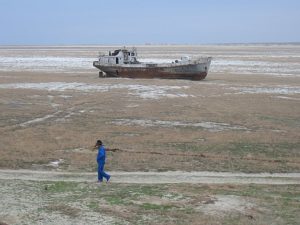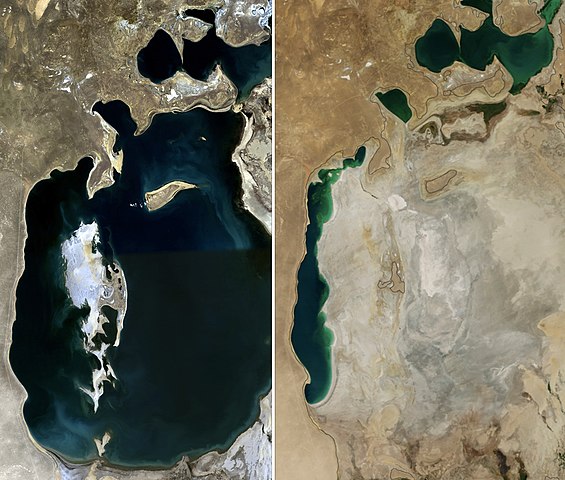Read this article in 4 levels: Basic A1 (英検3級), Intermediate B1(英検2級), Advanced C1(英検1級), original version. Multiple choice content questions for each level. Free English reading practice. The more you read in English, the more your English will improve. Today, let’s read about what happened to the Aral Sea.
A1 Beginner 英検3級
B1 Intermediate 英検2級
C1 Advanced 英検1級
Original

A1 Level Beginner 英検3級
What Happened to a Big Lake?
Long ago, the Aral Sea was a huge lake found between two places called Kazakhstan and Uzbekistan. It was so big and important for many reasons. But, many years ago, people decided to change the rivers that flowed into this lake. They wanted the water to grow plants like cotton on the nearby lands. Because of these changes, the Aral Sea began to shrink, getting smaller and smaller over time.
This lake was incredibly important for both people and animals. They relied on it for clean drinking water and as a source of food. However, once the rivers were redirected for farming, the Aral Sea couldn’t maintain its size and started to dry up. Nowadays, it is much smaller than it was in the past.
As the lake shrank, it became more and more difficult for local communities to find food and work. The land around the now smaller lake turned barren, unable to support the growth of plants. Additionally, the weather patterns have changed significantly; summers have become hotter, and winters, are colder.
People in the area have been trying to come up with solutions to this problem, but it’s a challenging situation. The need for water to grow cotton, a major agricultural product, conflicts with the need to restore the lake. It’s a tough balance to achieve, especially considering how many people depend on cotton farming for their livelihoods.
Questions
Where was the big lake, the Aral Sea?
– A) Next to Russia and China
– B) Between two places, Kazakhstan and Uzbekistan
– C) Between two big countries, Canada and the USA
– D) Between India and Pakistan
2. Why did the big lake start to get smaller?
– A) Because the weather changed a lot
– B) Because water went up into the air
– C) Because people used the water for plants
– D) Because too many fish were taken
3. What did the big lake give to people and animals?
– A) Light
– B) Water and food
– C) Shiny yellow metal
– D) A way to go places
4. How did the weather change because the big lake got smaller?
– A) It stayed the same
– B) It got less hot in summer
– C) It got less cold in winter
– D) Summers got hotter and winters got colder
5. What plant needs a lot of water that people grow now?
– A) A grain people make bread from
– B) A yellow plant
– C) Cotton
– D) A plant people make rice from
6. What is hard for people now that the lake is smaller?
– A) Going places
– B) Getting jobs and food
– C) Catching fish
– D) Swimming
7. Why is it hard to make the lake big again?
– A) It costs too much money
– B) Nobody wants to help
– C) People need water for plants
– D) You can’t do it
8. What happened to the ground around the lake?
– A) It got really good for plants
– B) It became a woods
– C) It can’t grow plants well now
– D) Many people come to see it
Answers: 1B 2C 3B 4D 5C 6B 7C 8C
B1 Level Intermediate 英検2級
The Shrinking of the Aral Sea
The Aral Sea, once ranked as the fourth largest lake in the world, lay between Kazakhstan and Uzbekistan. Back in the 1960s, a significant decision by the Soviet Union set its fate; the rivers feeding this vast lake were diverted to irrigate crops, including cotton, which began the gradual drying of the Aral Sea.
This lake was a lifeline for the people and wildlife in its vicinity, providing essential drinking water and being a rich fishing ground. However, the redirection of its tributaries meant it could no longer sustain its original size. By the year 2014, the Aral Sea had shrunk dramatically, becoming a fraction of its former self.
The impact of this shrinkage was severe. Communities that once thrived by the lake’s shore faced unemployment and food scarcity as the surrounding lands became infertile. Pollution increased as the area became more arid, and the change in weather patterns led to hotter summers and colder winters, further complicating the lives of the local people.
This scenario highlights the profound effects of altering natural ecosystems. Restoring the Aral Sea presents a complex challenge, as it would directly impact the region’s cotton farming, which has grown to be a significant economic activity. The situation underscores the delicate balance between human development and environmental conservation.
Questions
1. When did the Soviet Union start using the rivers for agriculture?
A) 1950s
B) 1960s
C) 1970s
D) 1980s
2. What was the Aral Sea’s rank in terms of size worldwide before it began to shrink?
A) First
B) Second
C) Third
D) Fourth
3. What kind of problems did the shrinking of the Aral Sea cause?
A) Loss of jobs and difficulty growing food
B) Increased tourism
C) Improved water quality
D) More fishing opportunities
4. How has the climate changed around the Aral Sea?
A) It became wetter
B) It has not changed
C) Hotter summers and colder winters
D) Cooler summers and warmer winters
5. What does the shrinking of the Aral Sea illustrate?
A) The success of large-scale farming
B) The impact of changing nature
C) The benefits of river diversion
D) The resilience of aquatic ecosystems
6. Why is restoring the Aral Sea challenging?
A) Lack of technology
B) Political disagreements
C) Economic dependence on cotton farming
D) Geological changes
7. What was a direct consequence of diverting rivers away from the Aral Sea?
A) Increased biodiversity
B) Enhanced regional cooperation
C) The lake began to dry up
D) Improved soil moisture
8. What industry has grown important in the area due to the water diversion?
A) Technology
B) Cotton farming
C) Tourism
D) Fishing
Answers 1B 2D 3A 4C 5B 6C 7C 8B
C1 Level Advanced 英検1級
The Environmental Catastrophe of the Aral Sea
The Aral Sea, once the fourth largest lake globally and nestled between Kazakhstan and Uzbekistan, has experienced a dramatic reduction in size since the 1960s. This decline was the result of the Soviet Union’s agricultural schemes, which saw the diversion of the Amu Darya and the Syr Darya rivers—vital sources of the lake’s water—for the irrigation of crops like cotton.
For the communities around the Aral Sea, it was more than just a body of water; it was a vital source of drinking water and fish, integral to their survival and livelihood. However, the strategic diversion of its feeder rivers began a devastating cycle of shrinkage and ecological degradation, reducing the lake to less than 10% of its original volume by 2014. This drastic change led to a significant increase in salinity levels, rendering the water inhospitable for aquatic life and devastating the local fishing industry.
The repercussions of this environmental disaster were far-reaching. The once-thriving communities surrounding the Aral Sea faced economic disaster as their way of life, heavily dependent on the lake’s resources, disappeared. The agricultural practices responsible for the lake’s decline also introduced pollutants into the environment, leading to toxic dust storms as the lakebed dried. These storms spread contaminated dust across the region, further degrading the soil’s fertility. Additionally, the disappearance of the Aral Sea altered the local climate, leading to harsher winters and hotter, drier summers, exacerbating the living conditions for the local populations.
This tragic tale of the Aral Sea is a poignant reminder of the irreversible impact human actions can have on the environment. While there are theoretical solutions to restore the lake, such efforts would come at a high cost, particularly to the cotton industry that has flourished in its absence. This situation presents a complex challenge: how to reconcile the need for economic development with the imperative of environmental preservation, a dilemma that remains unresolved.
Questions
1. What was the primary reason for the Aral Sea’s drastic reduction in size?
A) Global warming
B) Industrial pollution
C) Diversion of feeder rivers for agriculture
D) Natural desertification
2. By 2014, to what extent had the Aral Sea shrunk?
A) 25% of its original size
B) 50% of its original size
C) Less than 10% of its original size
D) It completely vanished
3. What was a major ecological impact of the Aral Sea’s shrinkage?
A) Improved water clarity
B) Increase in salinity levels
C) Growth of new forests
D) Expansion of marine life habitats
4. How did the local climate change as a result of the Aral Sea shrinking?
A) It became more humid
B) Less seasonal variation
C) Harsher winters and hotter, drier summers
D) More rainfall
5. What significant effect did agricultural runoff have on the area?
A) Enhanced soil fertility
B) Increased crop yields
C) Creation of toxic dust storms
D) Reduction in water usage
6. What dilemma does restoring the Aral Sea present?
A) It would increase global warming
B) It would threaten the local cotton industry
C) It would require relocating many communities
D) It would lead to overfishing
7. How did the diversion of rivers affect the local economy?
A) It led to a technology boom
B) It caused economic ruin for communities dependent on the lake
C) It had no significant impact
D) It boosted the tourism industry
8. What does the situation of the Aral Sea exemplify?
A) The benefits of modern agriculture
B) The success of water conservation efforts
C) The irreversible harm humans can cause to the environment
D) The adaptability of aquatic ecosystems
Answers 1C 2C 3B 4C 5C 6B 7B 8C
Original article
What happened to the Aral Sea? The Soviet Union diverted the rivers that fed it in the 1960s and it has almost completely dried up.
The Aral Sea was located between Kazakhstan in the north and Uzbekistan in the south. It formed between 23 and 2.3 million years ago. It was a fairly shallow lake, but it was the fourth largest lake in the world. The largest lake is the Caspian Sea at 389,000 km2, the second is Lake Huron-Michigan at 117,620 km2, the third lake is Lake Superior at 82,100 km2, and the Aral Sea would have come in fourth at 68,000 km2. The Aral Sea was a water source for all of the communities that lived around it and a source of fish. It was a saltwater body of water, which is why it is called a sea.
The Soviet Union formed in December 1922. The October Revolution of 1917 had overthrown the government and dissolved the Russian Empire. Many of the states that had been part of the Russian Empire became independent. That only lasted for a short time and they were soon swallowed up by the growing Soviet Union. Uzbekistan became part of the Soviet Union in 1924. Kazakhstan became a Soviet republic in 1936. The Soviet Union controlled both countries and all of the land around them, which included the Aral Sea and the rivers that fed it.
The Aral Sea was in an area that is predominantly desert and is very hot. In the summer, temperatures can reach 60℃. Because it is so hot, there was a lot of evaporation from the surface of the Aral Sea. The Aral Sea was fed by the Amu Darya and the Syr Darya, which are two very large rivers. Both of the rivers start in the mountains in the north of Afghanistan and they carried an enormous volume of snowmelt down into the Aral Sea. The volume of the two rivers was enough to offset the amount of evaporation, keeping the lake’s volume fairly constant. The Aral Sea received about 60 km3 of water a year from both of these rivers. The mountains that are the source of the rivers that feed the Aral Sea are also the reason why the whole area is a desert. They block the rain coming up and keep the area arid.
In the 1960s, the Soviet Government, under the leadership of Nikita Khrushchev, decided that they wanted to grow rice, melon, cereals, and cotton on the plains of the desert. In order to do this, they needed water. All of these crops require a large amount of water. It takes roughly 10,000 liters of water to produce 1 kg of cotton. The only source of water available were the Amu Darya and the Syr Darya rivers. The Soviet Government diverted both rivers without considering the consequences. Or, rather more scarily, they did consider the consequences and decided to divert the rivers anyway.
It took a while to divert the rivers, but, by 1980, the Aral Sea was receiving no water from either river and the plains of Uzbekistan were able to produce cotton. Today, Uzbekistan is one of the world’s largest exporters of cotton. The Aral Sea was not receiving the 60 km3 of freshwater a year and it started to evaporate. By 2014, it had shrunk to less than 10% of its original size. As well as that, because it was a saltwater lake, the salinity had become very concentrated and it was 3 times more saline than seawater. Fish cannot survive in water that salty.
The actions of the USSR have had several consequences. The first is the devastation of the communities that lived around the lake. They used the lake for food and for their livelihood. Without it, they have no jobs. The second is pollution. Fertilizers and pesticides used on the land around the lake have ended up in the lake. Then, when the lake vanished, the pollutants became dust on the lakebed that combines with salt and blows onto neighboring fields, making to impossible for the people who live near the lake to grow crops. The climate has changed as well. The lake moderated the temperature. Without it, winters are colder and summers are hotter and drier.
This is a terrible situation, but it is a very clear example of what humans can do. The problem is technically reversible, but then the cotton industry that has grown up in Uzbekistan would be decimated. What is the solution?Questions
1. When did the Soviet Union divert the rivers that fed the Aral Sea?
– A) In the 1950s
– B) In the 1960s
– C) In the 1970s
– D) In the 1980s
2. What was the primary reason for diverting the rivers?
– A) To increase fishing areas
– B) To grow crops like cotton
– C) To create more land for housing
– D) To prevent flooding
3. What is the Aral Sea primarily known for providing to the surrounding communities?
– A) Oil
– B) Gold
– C) Water and fish
– D) Natural gas
4. By what year had the Aral Sea received no water from the diverted rivers?
– A) 1975
– B) 1980
– C) 1985
– D) 1990
5. Which country is now one of the world’s largest exporters of cotton, thanks to the irrigation from the diverted rivers?
– A) Kazakhstan
– B) Russia
– C) Uzbekistan
– D) Afghanistan
6. What was a significant environmental impact of the Aral Sea shrinking?
– A) The region became more humid
– B) Increased biodiversity
– C) The creation of new rivers
– D) Increased salinity making it hard for fish to survive
7. What has been one of the consequences for communities around the Aral Sea?
– A) Increased tourism
– B) Improved air quality
– C) Loss of livelihood and food sources
– D) More agricultural land
8. What makes reversing the damage to the Aral Sea challenging?
– A) Lack of public interest
– B) The importance of the cotton industry
– C) Geological changes
– D) International regulations
Answers 1D 2B 3C 4D 5A 6A 7C 8B
Image: By User:Staecker – Own work, Public Domain, https://commons.wikimedia.org/w/index.php?curid=658367
Article: https://ilearnedthistoday.com/index.php/2024/03/02/what-happened-to-the-aral-sea/




Leave a Reply